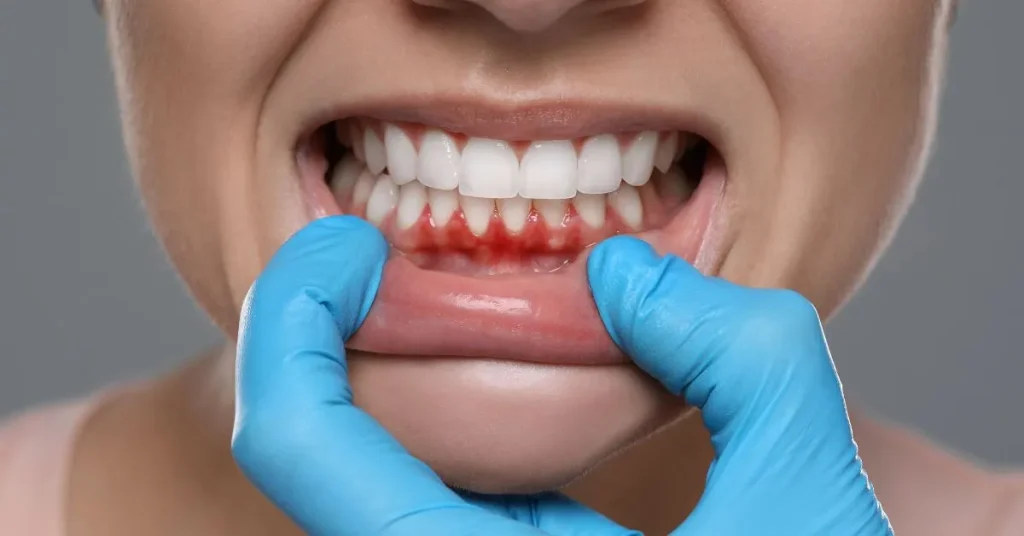How Gum Grafts Help Treat Gum Recession and Restore Oral Health
Gum recession happens when your gum tissue starts to pull away from your teeth, exposing the roots and putting your oral health at risk. Gum grafts are one of the most effective ways to fix this problem, helping to protect teeth, reduce sensitivity, and bring back a healthy smile.
What is Gum Recession?
Gum recession is a slow but serious dental issue. It usually begins without pain , which makes it easy to miss. You may first notice that your teeth look longer or that there’s a notch near the gumline. If left untreated, this condition can lead to tooth sensitivity, decay of the exposed roots, and eventually tooth loss. There are many causes for gum recession, including:
- Poor brushing technique
- Gum disease
- Smoking
- Genetic factors
- Teeth grinding or clenching
- Misaligned teeth
Unlike a cut or wound, gum tissue doesn’t grow back on its own. That’s where gum grafts come in.

How Do Gum Grafts Work?
A gum graft is a minor surgical procedure where healthy gum tissue is added to the affected area. The goal is to cover the exposed root surface and reinforce the gumline. Depending on the condition of your gums, your dentist may use tissue from the roof of your mouth or from nearby gum tissue. There are different types of gum grafts:
- Connective tissue grafts – most common; taken from beneath the top layer of the palate
- Free gingival grafts – tissue is taken directly from the roof of the mouth
- Pedicle grafts – tissue is taken from the gum near the tooth needing treatment
An expert dentist will decide the best approach based on your needs.
Why Gum Grafts Are More Than Just a Cosmetic Fix
Gum grafting isn’t just about appearances. While it does improve your smile, it also serves critical functions in restoring your oral health. Here’s what it helps with:
- Stops further gum recession
- Reduces sensitivity to hot or cold
- Prevents bone loss
- Improves oral hygiene by eliminating deep pockets
- Strengthens teeth that have become unstable
The exposed roots from gum recession are more prone to decay and wear. Covering them not only protects your teeth but also improves your ability to clean them.
What to Expect During the Procedure
The procedure usually takes about 60 to 90 minutes and is performed under local anaesthesia. Here’s a simple outline of what happens:
- Your dentist cleans the affected area.
- Tissue is carefully removed from the donor site.
- The new tissue is stitched over the recessed area.
- Both sites are covered with a dressing to aid healing.
Most people can return to work or normal routines the next day. Full healing may take a few weeks, during which you’ll need to follow specific care instructions, including eating soft foods and avoiding brushing the treated area directly.
Life After a Gum Graft
The benefits of gum grafting extend far beyond the surgery. Once healed, patients often report less tooth sensitivity and better confidence when smiling. More importantly, the graft acts as a shield, preventing further gum recession and protecting your teeth for years to come.
You’ll need to maintain strong oral hygiene habits to keep the benefits of your graft. This includes:
- Brushing gently with a soft-bristled toothbrush
- Flossing daily without snapping the floss into the gums
- Visiting your dentist for regular check-ups and cleanings
- Avoiding tobacco and managing stress, which can both affect gum health
Is Gum Grafting Right for You?
If you notice any of the following, speak with your dentist:
- Teeth that appear longer than usual
- Increased tooth sensitivity
- Bleeding gums
- Loose teeth
- A change in your bite
Early detection of gum recession means better outcomes and less extensive treatment. Gum grafting is often recommended when other treatments like deep cleaning aren’t enough.
Addressing Common Misconceptions
Let’s clear up a few myths about gum grafts and gum recession:
“It’s just cosmetic.”
It’s not. Gum recession exposes root surfaces that are not protected by enamel. This leads to decay, discomfort, and possible tooth loss.
“It’s painful.”
The procedure is relatively simple, and most patients report mild discomfort similar to a scraped knee. Over-the-counter pain relief is usually enough.
“Only older adults need this.”
Recession can occur at any age, especially in people who brush too hard, use tobacco, or have misaligned teeth. Many young adults undergo gum grafting.
Benefits of Gum Grafting – Quick Snapshot
Here’s why it’s worth considering if you’re facing gum recession:
- Protects teeth from decay and loss
- Reduces or eliminates sensitivity
- Improves the appearance of your smile
- Strengthens and stabilises the gumline
- Supports long-term oral health
Choosing the Right Dentist
Successful gum grafting depends on skill and proper planning. Choosing a dental clinic that specialises in both preventive care and surgical treatments ensures you’re in safe hands. A personalised approach to managing gum recession can make a huge difference in results and recovery.
At Rouse Hill Smiles Dental Clinic, experienced dentists evaluate the extent of gum recession and offer solutions tailored to your needs. The team uses modern techniques and provides aftercare that supports a smooth healing journey.
Gum grafts provide a lasting solution for gum recession, helping restore oral health by covering exposed roots, preventing further damage, and giving your smile a fresh start. This simple procedure can have a big impact on your comfort, confidence, and dental wellbeing.
Book your consultation at Rouse Hill Smiles Dental Clinic today and give your gums the care they deserve.
Our Principal Dentist
Dr. Teena and the Rouse Hill Smiles team are dedicated to providing patients of all ages with the highest quality of care.

Dr. Teena Bali
Dentist
Quick Contacts
- Rouse Hill Plaza G07-G08, 2-4 Aberdour Avenue Rouse Hill, NSW 2155
- enquiries@rousehillsmilesdentalcare.com.au
- (02) 8320 0548
- Copyright 2025 Rouse Hill Smiles Dental Care







